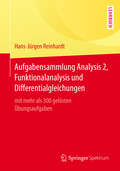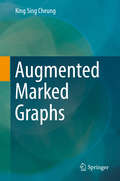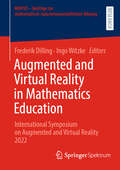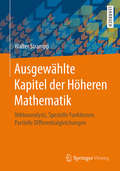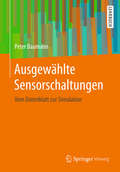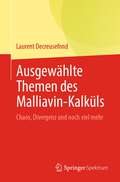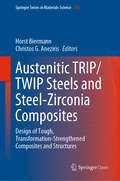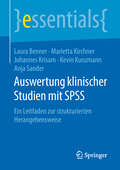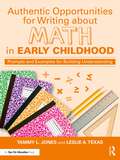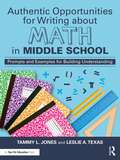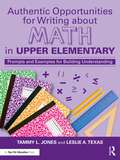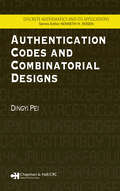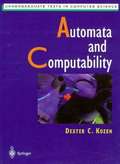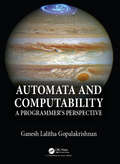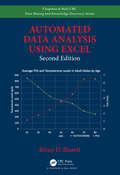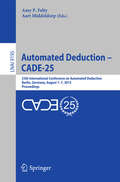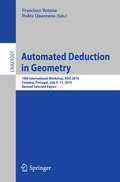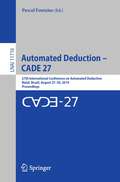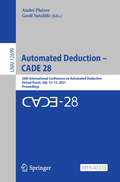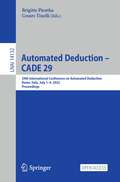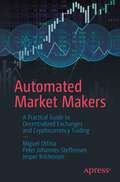- Table View
- List View
Aufgabensammlung Analysis 2, Funktionalanalysis und Differentialgleichungen: mit mehr als 300 gelösten Übungsaufgaben
by Hans-Jürgen ReinhardtSie suchen #65533;bungen zur Klausurvorbereitung, Material f#65533;r Tutorien oder Beispiele f#65533;r eine Vorlesung zur weiterf#65533;hrenden Analysis? In diesem umfangreichen Buch finden Sie eine Vielzahl verschiedener Aufgaben - von abstrakten Beweisen #65533;ber theoretische und angewandte Beispiele hin zu konkreten Berechnungen. Zur #65533;berpr#65533;fung der eigenen Arbeit gibt es ausf#65533;hrliche L#65533;sungen zu jeder Aufgabe. Somit ist das vorliegende Werk das ideale Begleitbuch sowohl f#65533;r Studierende als auch f#65533;r Dozenten der Mathematik. Die Zusammenstellung von #65533;bungsaufgaben entstand w#65533;hrend der entsprechenden Vorlesungen des Autors an der Universit#65533;t Siegen in den Jahren 1993 bis 2013.
Aufgabensammlung Numerik
by Hans-Jürgen ReinhardtDiese Aufgabensammlung zur Numerik des Bachelor- und Masterstudiums ist das ideale Begleitbuch sowohl für Studierende als auch für Dozenten der Mathematik.Suchen Sie Übungen zur Klausurvorbereitung oder Beispiele für Ihre Vorlesung? Dieses umfangreiche Buch deckt das gesamte Themenspektrum der Numerik ab – von den Grundlagen über gewöhnliche und partielle Differentialgleichungen bis hin zur Methode der Finiten Elemente. Dabei umfasst die Art der Aufgaben sowohl theoretische Beweise wie auch konkrete Berechnungen ab. Zur Überprüfung der eigenen Arbeit gibt es ausführliche Lösungen zu jeder Aufgabe.Die Zusammenstellung von Übungsaufgaben entstand während der entsprechenden Vorlesungen des Autors an der Universität Siegen in den Jahren 1989 bis 2015.
Augmented Marked Graphs
by King Sing CheungPetri nets are a formal and theoretically rich model for the modelling and analysis of systems. A subclass of Petri nets, augmented marked graphs possess a structure that is especially desirable for the modelling and analysis of systems with concurrent processes and shared resources. This monograph consists of three parts: Part I provides the conceptual background for readers who have no prior knowledge on Petri nets; Part II elaborates the theory of augmented marked graphs; finally, Part III discusses the application to system integration. The book is suitable as a first self-contained volume on augmented marked graphs, and will be useful to both researchers and practitioners in the fields of Petri nets and system integration.
Augmented and Virtual Reality in Mathematics Education: International Symposium on Augmented and Virtual Reality 2022 (MINTUS – Beiträge zur mathematisch-naturwissenschaftlichen Bildung)
by Frederik Dilling Ingo WitzkeAugmented and virtual reality (AR/VR) are technologies of increasing importance in our society. In the field of mathematics education, these innovative technologies may offer a wide range of opportunities to support immersive, individual, and active learning processes. At the same time, many new challenges arise that need to be mastered by teachers and students in the classroom. With this book we want to contribute to the discourse by presenting innovative insights by bringing parties from research and practice together. The papers cover a wide range of relevant topics including cooperation and communication, STEM and modelling, development and application of design criteria, spatial geometry and imagination or teacher-trainings. The contributions include in-depth theoretical considerations, concrete developed applications and learning environments, and findings from empirical studies.
Ausgewählte Kapitel der Höheren Mathematik: Vektoranalysis, Spezielle Funktionen, Partielle Differentialgleichungen
by Walter StramppAnimationen im Internet veranschaulichen z. B. die Wellengleichung durch eine schwingende Membran, die Wärmeleitung durch eine abnehmende Temperaturverteilung und die Potentialgleichung durch ein von der Randbelegung aufgeprägtes Potenzial. Welche Methoden verbergen sich dahinter, wie erzeugt man diese Animationen? Darauf soll der Leser eine erschöpfende Antwort geben können. Auf ausführliche, formale Beweise wird verzichtet. Die Begriffe werden mittels Beispielen und Graphiken in ihren Grundideen veranschaulicht und motiviert. Der Leser soll Hintergrundwissen und Lösungskompetenz bekommen, damit er sich nicht mit der Formelmanipulation zufrieden geben muss. Studierende sollen in die Lage versetzt werden, Probleme, die sich aus ihrer Bachelor/Masterarbeit oder aus den Anwendungen ergeben, zu bearbeiten.
Ausgewählte Sensorschaltungen: Vom Datenblatt zur Simulation
by Peter BaumannIn diesem Buch werden die Schritte angegeben, mit denen man aus den Datenblättern der Sensor-Hersteller die Modellparameter ermitteln kann, die zu einer Schaltungssimulation benötigt werden. Des Weiteren wird gezeigt, wie dem jeweiligen Sensor die Abhängigkeit von Temperatur, Feuchte, Licht, Druck, Kraft oder Magnetfeld in Gleichungsform aufge-prägt werden kann. Zu Sensorschaltungen wie Bandabstandsquelle, Feuchtesensor, RGB-Farbsensor, Reflexlichtschranke oder DMS-Brücke auf einem Baustahl-Biegestab werden die PSPICE-Analysen ausführlich dokumentiert. Die simulierten Sensorschaltungen können für sich und als Ausgangspunkt zu Messungen im Rahmen der Bachelor-Ausbildung genutzt werden.
Ausgewählte Themen des Malliavin-Kalküls: Chaos, Divergenz und noch viel mehr
by Laurent DecreusefondDieses Buch ist keine Forschungsmonographie zum Malliavin-Kalkül mit neuesten Ergebnissen und besonders anspruchsvollen Beweisen. Es enthält nicht alle Ergebnisse, die für die behandelten grundlegenden Themen bekannt sind. Das Ziel ist vielmehr, eine möglichst große Vielfalt an Beweistechniken zu bieten. Zum Beispiel haben wir uns nicht auf den Beweis der Konzentrationsungleichung für Funktionale der Brownschen Bewegung konzentriert, da er sich eng an das analoge Ergebnis für Poisson-Funktionale anlehnt. Dieses Buch ist aus den Graduiertenkursen entstanden, die ich in den letzten Jahren an den Universitäten Paris-Sorbonne und Paris-Saclay gehalten habe. Es soll so zugänglich wie möglich für Studierende sein, die über Kenntnisse der Itô-Kalkulation und einige Grundlagen der Funktionalanalysis verfügen.Die Übersetzung wurde mit Hilfe von künstlicher Intelligenz durchgeführt. Eine anschließende menschliche Überarbeitung erfolgte vor allem in Bezug auf den Inhalt.
Austenitic TRIP/TWIP Steels and Steel-Zirconia Composites: Design of Tough, Transformation-Strengthened Composites and Structures (Springer Series in Materials Science #298)
by Horst Biermann Christos G. AnezirisThis open access book presents a collection of the most up-to-date research results in the field of steel development with a focus on pioneering alloy concepts that result in previously unattainable materials properties. Specifically, it gives a detailed overview of the marriage of high-performance steels of the highest strength and form-ability with damage-tolerant zirconia ceramics by innovative manufacturing technologies, thereby yielding a new class of high-performance composite materials. This book describes how new high-alloy stainless TRIP/TWIP steels (TRIP: TRansformation-Induced Plasticity, TWIP: TWinning-induced Plasticity) are combined with zirconium dioxide ceramics in powder metallurgical routes and via melt infiltration to form novel TRIP-matrix composites. This work also provides a timely perspective on new compact and damage-tolerant composite materials, filigree light-weight structures as well as gradient materials, and a close understanding of the mechanisms of the phase transformations.With a detailed application analysis of state-of-the-art methods in spatial and temporal high-resolution structural analysis, in combination with advanced simulation and modelling, this edited volume is ideal for researchers and engineers working in modern steel development, as well as for graduate students of metallurgy and materials science and engineering.
Auswertung klinischer Studien mit SPSS: Ein Leitfaden zur strukturierten Herangehensweise (essentials)
by Laura Benner Marietta Kirchner Johannes Krisam Kevin Kunzmann Anja SanderNach Abschluss der Datenerhebung im Rahmen einer Doktorarbeit oder einer eigens durchgeführten klinischen Studie stellen sich viele Mediziner oftmals die Frage: Was nun tun mit der Fülle an Daten? Laura Benner, Marietta Kirchner, Johannes Krisam, Kevin Kunzmann und Anja Sander stellen anhand eines Datenbeispiels aus der Onkologie dar, wie man seine Studiendaten unter Kontrolle bringt und planvoll an die statistische Auswertung herangeht. Mithilfe der Statistiksoftware SPSS veranschaulichen sie die einzelnen Schritte einer Datenauswertung und gehen neben der Darstellung von Programmfunktionen in SPSS auch auf die statistische Methodik der Auswertungsschritte und die richtige Interpretation und Einordnung der Ergebnisse ein.Die Autoren Als wissenschaftliche Mitarbeiter des Instituts für Medizinische Biometrie und Informatik der Universität Heidelberg sind alle Autoren permanent damit beschäftigt, durch Statistik die Gesundheit von Menschen und somit auch (ein bisschen) die Welt zu verbessern. Neben alltäglichen statistischen Nöten von Medizinstudenten und Klinikumsmitarbeitern kümmern sie sich zudem noch um universitäre Lehre, Projektarbeit in klinischen Studien und ihre eigenen methodisch-statistischen Forschungsprojekte.
Authentic Opportunities for Writing about Math in Early Childhood: Prompts and Examples for Building Understanding
by Tammy L. Jones Leslie A. TexasTeach students to write about math so they can improve their conceptual understanding in authentic ways. This resource offers hands-on strategies you can use to help students in grades PreK–2 discuss and articulate mathematical ideas, use correct vocabulary, and compose mathematical arguments.Part One discusses the importance of emphasizing language to make students’ thinking visible and to sharpen communication skills, while attending to precision. Part Two provides a plethora of writing prompts and activities: Visual Prompts; Compare and Contrast; The Answer Is; Topical Questions; Writing About; Journal Prompts; Poetry/Prose; Cubing and Think Dots; RAFT; Question Quilts; and Always, Sometimes, Never. Each activity is accompanied by a clear overview plus a variety of examples. Part Three offers a crosswalk of writing strategies and math topics to help you plan, as well as a sample anchor task and lesson plan to demonstrate how the strategies can be integrated.Throughout each section, you’ll also find Blackline Masters that can be downloaded for classroom use. With this book’s engaging, standards-based activities, you’ll have young children communicating like fluent mathematicians in no time!
Authentic Opportunities for Writing about Math in High School: Prompts and Examples for Building Understanding
by Tammy L. Jones Leslie A TexasTeach students to write about math so they can improve their conceptual understanding in authentic ways. This resource offers hands-on strategies you can use to help students in grades 9–12 discuss and articulate mathematical ideas, use correct vocabulary, and compose mathematical arguments.Part One discusses the importance of emphasizing language to make students’ thinking visible and to sharpen communication skills, while attending to precision. Part Two provides a plethora of writing prompts and activities: Visual Prompts; Compare and Contrast; The Answer Is; Topical Questions; Writing About; Journal Prompts; Poetry/Prose; Cubing and Think Dots; RAFT; Question Quilt; and Always, Sometimes, and Never. Each activity is accompanied by a clear overview plus a variety of examples. Part Three offers a crosswalk of writing strategies and math topics to help you plan, as well as a sample anchor task and lesson plan to demonstrate how the strategies can be integrated.Throughout each section, you’ll also find Blackline Masters that can be downloaded for classroom use. With this book’s engaging, standards-based activities, you’ll have your high school students communicating like fluent mathematicians in no time!
Authentic Opportunities for Writing about Math in Middle School: Prompts and Examples for Building Understanding
by Tammy L. Jones Leslie A. TexasTeach students to write about math so they can improve their conceptual understanding in authentic ways. This resource offers hands-on strategies you can use to help students in grades 6–8 discuss and articulate mathematical ideas, use correct vocabulary, and compose mathematical arguments.Part One discusses the importance of emphasizing language to make students’ thinking visible and to sharpen communication skills, while attending to precision. Part Two provides a plethora of writing prompts and activities: Visual Prompts; Compare and Contrast; The Answer Is; Topical Questions; Writing About; Journal Prompts; Poetry; Cubing and Think Dots; RAFT; Question Quilts; and Always, Sometimes, Never. Each activity is accompanied by a clear overview plus a variety of examples. Part Three offers a crosswalk of writing strategies and math topics to help you plan, as well as a sample anchor task and lesson plan to demonstrate how the strategies can be integrated.Throughout each section, you’ll also find Blackline Masters that can be downloaded for classroom use. With this book’s engaging, standards-based activities, you’ll have your middle school students communicating like fluent mathematicians in no time!
Authentic Opportunities for Writing about Math in Upper Elementary: Prompts and Examples for Building Understanding
by Tammy L. Jones Leslie A. TexasTeach students to write about math so they can improve their conceptual understanding in authentic ways. This resource offers hands-on strategies you can use to help students in grades 3–5 discuss and articulate mathematical ideas, use correct vocabulary, and compose mathematical arguments.Part One discusses the importance of emphasizing language to make students’ thinking visible and to sharpen communication skills, while attending to precision. Part Two provides a plethora of writing prompts and activities: Visual Prompts; Compare and Contrast; The Answer Is; Topical Questions; Writing About; Journal Prompts; Poetry/Prose; Cubing and Think Dots; RAFT; Question Quilts; and Always, Sometimes, Never. Each activity is accompanied by a clear overview plus a variety of examples. Part Three offers a crosswalk of writing strategies and math topics to help you plan, as well as a sample anchor task and lesson plan to demonstrate how the strategies can be integrated.Throughout each section, you’ll also find Blackline Masters that can be downloaded for classroom use. With this book’s engaging, standards-based activities, you’ll have your upper elementary students communicating like fluent mathematicians in no time!
Authentication Codes and Combinatorial Designs (Discrete Mathematics and Its Applications)
by Dingyi PeiResearchers and practitioners of cryptography and information security are constantly challenged to respond to new attacks and threats to information systems. Authentication Codes and Combinatorial Designs presents new findings and original work on perfect authentication codes characterized in terms of combinatorial designs, namely strong partially
Automata and Computability
by Dexter C. KozenThis textbook provides undergraduate students with an introduction to the basic theoretical models of computability. Students who have already some experience with elementary discrete mathematics will find this a well-paced first course. Plenty of exercises are provided, ranging from the easy to the challenging.
Automata and Computability: A Programmer's Perspective
by Ganesh GopalakrishnanAutomata and Computability is a class-tested textbook which provides a comprehensive and accessible introduction to the theory of automata and computation. The author uses illustrations, engaging examples, and historical remarks to make the material interesting and relevant for students. It incorporates modern/handy ideas, such as derivative-based parsing and a Lambda reducer showing the universality of Lambda calculus. The book also shows how to sculpt automata by making the regular language conversion pipeline available through a simple command interface. A Jupyter notebook will accompany the book to feature code, YouTube videos, and other supplements to assist instructors and studentsFeatures Uses illustrations, engaging examples, and historical remarks to make the material accessible Incorporates modern/handy ideas, such as derivative-based parsing and a Lambda reducer showing the universality of Lambda calculus Shows how to "sculpt" automata by making the regular language conversion pipeline available through simple command interface Uses a mini functional programming (FP) notation consisting of lambdas, maps, filters, and set comprehension (supported in Python) to convey math through PL constructs that are succinct and resemble math Provides all concepts are encoded in a compact Functional Programming code that will tesselate with Latex markup and Jupyter widgets in a document that will accompany the books. Students can run code effortlessly href="https://github.com/ganeshutah/Jove.git/"here.
Automated Data Analysis Using Excel (Chapman & Hall/CRC Data Mining and Knowledge Discovery Series)
by Brian D. BissettThis new edition covers some of the key topics relating to the latest version of MS Office through Excel 2019, including the creation of custom ribbons by injecting XML code into Excel Workbooks and how to link Excel VBA macros to customize ribbon objects. It now also provides examples in using ADO, DAO, and SQL queries to retrieve data from databases for analysis. Operations such as fully automated linear and non-linear curve fitting, linear and non-linear mapping, charting, plotting, sorting, and filtering of data have been updated to leverage the newest Excel VBA object models. The text provides examples on automated data analysis and the preparation of custom reports suitable for legal archiving and dissemination. Functionality Demonstrated in This Edition Includes: Find and extract information raw data files Format data in color (conditional formatting) Perform non-linear and linear regressions on data Create custom functions for specific applications Generate datasets for regressions and functions Create custom reports for regulatory agencies Leverage email to send generated reports Return data to Excel using ADO, DAO, and SQL queries Create database files for processed data Create tables, records, and fields in databases Add data to databases in fields or records Leverage external computational engines Call functions in MATLAB® and Origin® from Excel
Automated Deduction - CADE-25: 25th International Conference on Automated Deduction, Berlin, Germany, August 1-7, 2015, Proceedings (Lecture Notes in Computer Science #9195)
by Amy P. Felty Aart MiddeldorpThis book constitutes the proceedings of the 25th International Conference on Automated Deduction, CADE-25, held in Berlin, Germany, in August 2015. The 36 revised full papers presented ( 24 full papers and 12 system descriptions) were carefully reviewed and selected from 85 submissions. CADE is the major forum for the presentation of research in all aspects of automated deduction, including foundations, applications, implementations and practical experience.
Automated Deduction in Geometry: 10th International Workshop, ADG 2014, Coimbra, Portugal, July 9-11, 2014, Revised Selected Papers (Lecture Notes in Computer Science #9201)
by Francisco Botana Pedro QuaresmaThis book constitutes the thoroughly refereed post-workshop proceedings of the 10th International Workshop on Automated Deduction in Geometry, ADG 2014, held in Coimbra, Portugal, in July 2014. The 11 revised full papers presented in this volume were carefully selected from 20 submissions. The papers show the trend set of current research in automated reasoning in geometry.
Automated Deduction – CADE 26: 26th International Conference on Automated Deduction, Gothenburg, Sweden, August 6–11, 2017, Proceedings (Lecture Notes in Computer Science #10395)
by Leonardo MouraThis book constitutes the proceeding of the 26th International Conference on Automated Deduction, CADE-26, held in Gothenburg, Sweden, in August 2017. The 26 full papers and 5 system descriptions presented were carefully reviewed and selected from 69 submissions. CADE is the major forum for the presentation of research in all aspects of automated deduction, including foundations, applications, implementations and practical experience. The chapter 'Certifying Confluence of Quasi-Decreasing Strongly Deterministic Conditional Term Rewrite Systems' is published open access under a CC BY 4. 0 license.
Automated Deduction – CADE 27: 27th International Conference on Automated Deduction, Natal, Brazil, August 27–30, 2019, Proceedings (Lecture Notes in Computer Science #11716)
by Pascal FontaineThis book constitutes the proceeding of the 27th International Conference on Automated Deduction, CADE 27, held in Natal, Brazil, in August 2019. The 27 full papers and 7 system descriptions presented were carefully reviewed and selected from 65 submissions. CADE is the major forum for the presentation of research in all aspects of automated deduction, including foundations, applications, implementations, and practical experience.
Automated Deduction – CADE 28: 28th International Conference on Automated Deduction, Virtual Event, July 12–15, 2021, Proceedings (Lecture Notes in Computer Science #12699)
by André Platzer Geoff SutcliffeThis open access book constitutes the proceeding of the 28th International Conference on Automated Deduction, CADE 28, held virtually in July 2021.The 29 full papers and 7 system descriptions presented together with 2 invited papers were carefully reviewed and selected from 76 submissions. CADE is the major forum for the presentation of research in all aspects of automated deduction, including foundations, applications, implementations, and practical experience. The papers are organized in the following topics: Logical foundations; theory and principles; implementation and application; ATP and AI; and system descriptions.
Automated Deduction – CADE 29: 29th International Conference on Automated Deduction, Rome, Italy, July 1–4, 2023, Proceedings (Lecture Notes in Computer Science #14132)
by Cesare Tinelli Brigitte PientkaThis open access book constitutes the proceedings of the 29th International Conference on Automated Deduction, CADE 29, which took place in Rome, Italy, during July 2023. The 28 full papers and 5 short papers presented were carefully reviewed and selected from 77 submissions. CADE is the major forum for the presentation of research in all aspects of automated deduction, including foundations, applications, implementations, and practical experience. The papers are organized in the following topics: Logical foundations; theory and principles; implementation and application; ATP and AI; and system descriptions.
Automated Market Makers: A Practical Guide to Decentralized Exchanges and Cryptocurrency Trading
by Miguel Ottina Peter Johannes Steffensen Jesper KristensenExplore Automated Market Makers (AMMs), the underlying protocols used by decentralized exchanges (DEX) to allow users to perform trades of cryptocurrencies in a decentralized way with no middlemen. This book provides a thorough study and a clear-cut exposition of the principal AMMs (Uniswap v2 and v3, Balancer, and Curve).You'll receive a detailed description of how these AMMs work, unveiling the mathematics behind them and showing plenty of examples as well as novel proofs for several interesting facts. Each chapter describes an AMM's core idea and derives the mathematical formulas used in the code, giving careful explanations of the logical thinking involved and detailing the steps needed to reach those formulas. All these explanations are complemented with thoughtfully chosen examples which further help to enlighten the readers on how the formulae work. In addition, the relevant parts of the codes of the AMMs are shown after explaining each formula so that the actual implementation of the formulae can be seen.In a traditional trading market a buy order has to be matched with a sell order to achieve a trade. However, for an AMM, users trade against the protocol itself, a smart contract, or a community pool of funds. In simple terms this is an open source computer program in which mathematical formulas define prices. Automated Market Makers examines this critical point revealing that no banks or intermediaries are necessary, giving crucial financial access to a much larger crowd, regardless of who they are with less barriers to access.What You'll LearnUnderstand the principals of decentralized finance (DeFi)Grasp mathematical formulae that underpin decentralized exchangesWork with Solidity programming languageReview current industry best practices Who This Book Is ForThose new to Blockchain and Cryptocurrency trading, who want to learn more about AMMsDevelopers who want to dive deeper into the core features of AMM platformsInvestors and venture capitalists who want to know more about new emerging technologies
Automated Reasoning with Analytic Tableaux and Related Methods: 26th International Conference, TABLEAUX 2017, Brasília, Brazil, September 25–28, 2017, Proceedings (Lecture Notes in Computer Science #10501)
by Renate A. Schmidt Cláudia NalonThis book contains the proceedings of the 26th International Conference on Automated Reasoning with Analytics Tableaux and Related Methods, TABLEAUX 2017, held in Bras#65533;lia, Bazil, in September 2017. The 19 contributed papers presented in this volume were carefully reviewed and selected from 27 submissions. They are organized in topical sections named: Sequent systems; tableaux; transitive closure and cyclic proofs; formalization and complexity. Also included are papers of three invited speakers.
